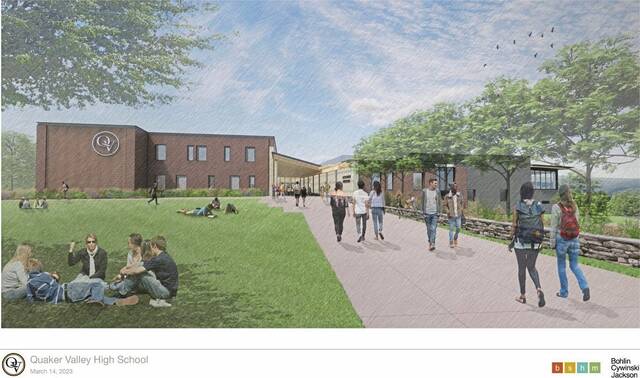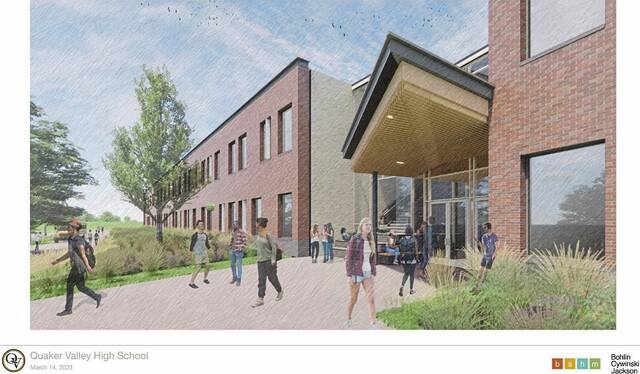More details of proposed Quaker Valley High School released by architects, full site plans yet to be submitted
Architects of the proposed Quaker Valley High School in Leet have revealed more renderings of the school facade.
The proposed school is on 150 acres of land off Camp Meeting Road. It straddles Edgeworth, Leetsdale and Leet.
Its latest update came in the form of a video presentation in mid-March by BSHM Architects and Bohlin Cywinski Jackson Architects.
Officials from both companies talked about exterior building materials, entrances, a media center, its courtyard and other parts of the facility.
The presentation featured slides of blended red brick, dark ashlar masonry and light Roman brick accenting entries with natural wood canopies and ceilings. Metal screening would be used on the roof to help conceal mechanical systems.
“We’re curating materials, colors, tones (and) textures that are drawn directly from the community,” said Kent Suhrbier, principal at Bohlin Cywinski Jackson Architects. “These materials are composed into a design that is intended to be timeless in its nature.”
The main entrance is along the building’s west side by a large open lawn. The school bus drop off is to the north, by other plantings. The media center and art courtyard are to the east and the cafeteria is to the south.
Slides show students sitting on a lawn while others moved along a walkway to the main entry with trees to its right.
The front offices are two stories tall and made with red brick. Both the main entrance and a side student entrance, as well as an “athletics wing” and media center have wood ceilings.
“This natural wood is a consistent element that ties all the school’s public spaces together,” Suhrbier said.
Bohlin Cywinski Jackson Architects associate principal Patricia Culley highlighted the media center courtyard and other facade plans.
“This outdoor space, with both landscape and hardscape, is to be used as a secure courtyard for the arts and engineering classes, as well as an outdoor extension area for the media center,” she said. “This space is intended for informal gatherings by individuals, small groups or larger collaborations.”
She also stressed how the chosen materials not only connect from interior to exterior, but “connect old and new.”
The presentation was posted on the district’s website and its YouTube channel.
School board members were impressed by what they saw.
“I am very pleased by the overall look of the exterior materials, as it blends into the surroundings nicely, and carries along with it the historic nature of our district’s buildings,” said Gianni Floro. “Paint requires painting. Hard surfaces are preferred to decrease maintenance. (For example) we are painting our house every few years. Good bricks and exterior materials do not need that, ultimately a cost saving with better materials on the exterior and interior.”
Floro said he couldn’t think of any items that might need to be changed, but there may be plan adjustments later on.
“As the project progresses, there may be required changes,” he said. “Especially considering that the Leet Township Planning Commission review may offer insight and public input.”
That’s when the district would bring the project before the planning commission, though township manager Betsy Rengers said the district had not submitted any plans as of press time.
The aforementioned architects did not respond to messages seeking further comments beyond the presentation.
Other companies also involved in the proposed school project include LaQuatra Bonci Associates, CNC Engineering and Phillips & Associates.
Previous updates
District officials gave an update on the project’s cost at a February school board meeting.
Scott Antoline, the district director of finance, said he is confident the project will remain within the $95 million to $105 million financial parameters set a few years ago, despite inflation.
Cost projections in June 2020 had the high school costing between $85 million to $95 million.
Antoline said the financial confidence comes from the work of the design team.
The project would be paid for through long-term bonds similar to what was done years ago for the middle and elementary schools.
Tax increases in the next five years would be between 3.4% and 2.9%, with 2% of that being annual hikes to just cover operational needs.
Antoline said both figures are less than the allowable tax hikes projected under the Act 1 index, a state formula that limits real estate tax increases without voters’ approval.
The district also may pull from its capital reserve fund, which is upwards of $4 million.
Further cost estimates are expected to be completed in the spring or early summer.
Michael DiVittorio is a TribLive reporter covering general news in Western Pennsylvania, with a penchant for festivals and food. He can be reached at mdivittorio@triblive.com.
Remove the ads from your TribLIVE reading experience but still support the journalists who create the content with TribLIVE Ad-Free.





